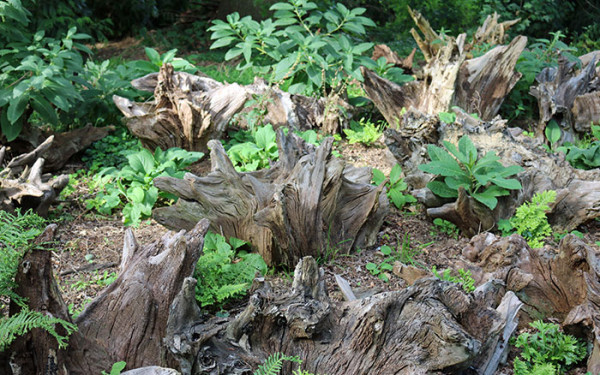Stumperies have been around for a long time as features in gardens, but they have recently seen a resurgence. They are a great way of attracting wildlife to the garden and can also look great as part of a woodland or wildlife garden too. They are similar to log piles but are a more permanent feature. So, here’s how more about stumperies for wildlife in the garden.
What is a stumpery?
Stumperies are made up of old tree roots, stems and stumps of trees. These are all combined, sometimes to great heights, to offer a space for wildlife.
Aesthetically, they look great as part of a wildlife garden, or zen garden where the interesting shapes and colours of the wood have an impact.
The irregularity of the wood piled together is part of their beauty.

Take a look back
Stumperies were a popular feature in gardens during the Victorian era. In the 19th Century, they were used as a way to draw attention to the beauty of nature. It’s thought that they rose in popularity because they acted as places to plant and display the many ferns that Victorians loved to showcase in their gardens. Ferns are shade and moisture loving plants, suited well to growing around stumperies.
Since then, they have been referred to as ‘Victorian horticultural oddities’. But it seems like they’re making a comeback, especially as many gardeners both beginners and keen greenfingered gurus are wanting to make gardens more accessible and inviting to wildlife.
The first stumpery was built in 1856 at Biddulph Grange in Staffordshire. This stumpery is made up from 10 foot walls, which are either side of the garden path.
Then, there’s the largest stumpery in Britain which is at King Charles III’s home; Highgrove House in Gloucestershire. Just like the Victorians, this stumpery is a brilliant backdrop for the many ferns within the garden, as well as the hostas which make up the King’s national collection.

Stumperies for wildlife
Within our gardens, it’s important to remember that it’s not just us who enjoys them. There are many creatures great and small that visit our gardens as a way to access food, water, and shelter. With many gardens incorporating features to attract wildlife, stumperies are another one that will keep many creatures happily coming back. Beetles, solitary bees, frogs, and woodlice are just some of the creatures who will appreciate this addition.

How to make a stumpery
As with many garden features, doing it yourself means you can create one the perfect size to suit the style, shape, and dimensions of your garden.
First, decide where to position the stumpery. A spot near a pond can be ideal as it allows wildlife to go between the two sites as insects, frogs, and other wildlife will appreciate the stumpery.
You can plan when to create the stumpery around timings of removing any trees or large shrubs from the garden. On the other hand, you can get the materials from family, friends, or neighbours that are getting rid of these. Alternatively, contact local tree surgeons or builders to check if there are any available from their jobs.
Before getting started, prepare the ground by forking over the area and removing any weeds.
Then, these next steps will depend on the amount of wood you have, and whether you are linking them together.
For the stumps, dig holes that are around three feet deep and placing them into the ground, with roots facing upwards. Push them tightly into the ground, fixing them firmly in place.
When they are in place, the area can be embellished with ferns, hostas, and other shade loving or woodland style plants. Some perfect plants for woodland gardens include ferns such as Asplenium scolopendrium (hart’s tongue fern), Polypodium vulgare (common polypody) and Asplenium trichomanes (maidenhair spleenwort). As well as flowers like bluebells, foxgloves, and the wonderfully fragranced Convallaria majalis (lily-of-the-valley).

Leave A Comment